|
.
In 1812 the Lifeguard Hussar's first encounter with
the French invaders was a specific one. Roman Soltyk writes:
"… a strong troop of Muscovite hussars halted at about a 100
paces from our weak advance guard. … Coming toward us,
the officer shut out in French: Qui vive ?
"France!" - our men reply quietly.
"What are you doing here ? F… off !" - shouted the hussar.
|

Guard Cavalry
On March 13th (25th) 1814 Pahlen outflanked the left wing
of the French near Lenharrée, while Depreradovich moved
against their right flank. The spearhead of the attacking
force was formed by the Lifeguard Uhlans having behind the
Guard Cavalry (Chevaliers). The uhlans in the instant broke
the French cavalry led by Bordesoulle and rushed in pursuit.
The uhlans captured 6 guns, the Guard Cavalry (Chevaliers)
also took 6 guns, while the Lifeguard Horse captured 3 guns.
The Guard cavalry consisted of all branches of cavalry.
The cuirassiers wore white uniforms, the dragoons and horse jagers wore green,
the uhlans wore dark blue, and the hussars and Cossacks wore red coats.
The horse gunners wore dark green outfits.
In Austerlitz Campiagn in 1805 the Guard cavalry comprised of:
 - Guard Cavalry Regiment (Chevaliers Garde, Kavallergarde) - Guard Cavalry Regiment (Chevaliers Garde, Kavallergarde)
 - Lifeguard Horse Regiment (Garde du Corps, Garde zu Pferde) - Lifeguard Horse Regiment (Garde du Corps, Garde zu Pferde)
 - Lifeguard Hussars - Lifeguard Hussars
 - Lifeguard Cossacks - Lifeguard Cossacks
In Austerlitz in 1805, the Guard Cavalry Regiment (Chevaliers Garde) were defeated by
arguably the best heavy cavalry in the world,
Napoleon's Guard Horse Grenadiers. In another encounter the Lifeguard Hussars delivered
a volley at the charging French Guard Chasseurs-a-Cheval but were ovethrown.
The Lifeguard Horse however enjoyed a great success.
They have captured Eagle and flag of the French 4th Line Infantry Regiment
(their chef was Napoleon's brother) and routed several infantry units.
After the Austerlitz Campaign, the guard was no longer a palace troop, they became
veterans. In 1806 officer D.V. Davydov wrote in his autobiography that when he was accepted
into the Guard cavalry "he smelled like milk while the guardsmen smelled like from gunpowder."
In Friedland in 1807, General Bison’s infantry division was
formed in two lines of battalion columns, which were in the act of forming squares
when the Russian cavalry struck them with impetuosity.
(Elting J.R., Esposito V. - “A Military History and Atlas of the Napoleonic Wars”,
Frederick A. Praeger Inc., New York 1964, description to Map 81)
The French infantry
fled to the rear with little or no resistance to the Russians.
Seeing the panick, General Marchand’s infantry division lost their cool too and raced to the
woods. Only “three infantry regiments” were able to form squares and stand firm
amid the chaos. According to Shikanov, it was the Russian guard cavalry and
Cossacks who attacked Marchand’s division and Latour-Mauborg’s dragoon division.
The 69th Line Infantry was swept away and its both battalion commanders, the regimental
commander Colonel Frirjon, and many officers were the casualties.
Other regiments panicked. Only the counterattack conducted by Latour-Mauborg’s
dragoons and the approach of Dupont’s infantry saved them from a total
destruction. The Eagle-bearer of 69th was sabered but falling down he covered
the Eagle with his body. The Russians somehow didn’t pick it up or maybe there was
no time to do it as the French dragoons soon counterattacked. Later on on this area
was Russian Pernau Infantry and they found the Eagle. The French sources also
claim that the 69th Line was destroyed by cavalry and not by infantry.
In 1812, before Napoleon's invasion of Russia, was issued an order that all army cavalry regiments
will supply the best soldiers to the cuirassiers and to the guard cavalry.
This process was under way already after 1806-1807 campaign. When there were not enough veterans, recruits filled the ranks.
For example in 1814 one squadron of the Lifeguard Horse Regiment was formed entirely of recruits.
Löwenstern described a review of cavalry regiments in which participated Tsar Alexander,
his brother Constantine and General Uvarov. The Tsar began selecting the best hussars and
dragoons. According to Löwenstern all the selected men looked very healthy and beautiful.
Only one man was selected from Lowenstern's Soumy Hussar Regiment into the prestigous Guard
Cavalry Regiment (Chevaliers). The best of the picked men were taken into
Lifeguard Dragoon Regiment. Only few joined the Lifeguard Uhlans and Lifeguard
Horse. The worst (physically) of the selected men, according to Lowenstern, went into the Lifeguard Hussars.
In Borodino in 1812, the Guard Cavalry (Chevaliers) stood in squadron columns with
intervals; in the first line were I and IV Squadron, and in the second the III and V.
The Lifeguard Horse was deployed to the left of the Guard Cavalry. Its four (I, III, IV, V)
squadrons were formed in one line, squadron by squadron with intervals.
When the trumpets crashed out with brazen voice the two regiments began their
magnificient advance against the Saxon cuirassiers.
Two small squadrons of Polish cuirassiers moved to the right in an attempt to protect the
flank of Saxon cuirassier against the Guard Cavalry Regiment (Chevaliers).
The fighting itself took place on a rye field and the onrush
on both sides was so terrific that some of the most forward horses and men went
down like poppies in a hurricane. The Saxons and Poles were utterly discomfited.
They were pursued until the positions of the French artillery and to make things
worse the fleeing Saxon Zastrow cuirassiers were mistakenly attacked by the French
horse carabiniers.
In 1813 the regiments that were admitted into the Guard before 1813 were
named Old Guard. Those admitted in 1813 were called Young (New) Guard.
The guardsmen in the Old Guard were two ranks above the army and those in the Young Guard
were one rank above the army counterparts. The Old and Young Guard filled their ranks
the same way.
In Spring 1814 the Guard cavalry comprised of:
 - Guard Cavalry Regiment (Chevaliers Garde, Kavallergarde) - Guard Cavalry Regiment (Chevaliers Garde, Kavallergarde)
 - Lifeguard Horse Regiment (Garde du Corps, Garde zu Pferde) - Lifeguard Horse Regiment (Garde du Corps, Garde zu Pferde)
 - Lifeguard Dragoon Regiment - Lifeguard Dragoon Regiment
 - Lifeguard Uhlan Regiment - Lifeguard Uhlan Regiment
 - Lifeguard Horse Jager Regiment - Lifeguard Horse Jager Regiment
 - Lifeguard Hussar Regiment - Lifeguard Hussar Regiment
 - Lifeguard Cossack Regiment - Lifeguard Cossack Regiment
Color of horses.
| regiment |
I Squadron |
II Squadron |
III Squadron |
IV Squadron |
Guard Cavalry Regiment (Chevalier Garde)
1812-1815 |
bays |
chestnuts |
grays |
blacks |
| Lifeguard Uhlan Regiment |
dark bays |
light bays |
chestnuts |
blacks |
|
|
Guard Cavalry Regiment
Russian name: Kavalergradski Polk, Kavalergardy
French name: Chevaliers Garde
German name: Kavalergarde
Chefs: General-Lieutenant Fedor P. Uvarov (General of Cavalry in Oct 1813).
Sometimes Tsar Alexander is given as the "First Chef" and Uvarov as the 'Second Chef.'
Commanders: General-Major Nikolai I. Depreradovich (in Aug 1813 GL)
This regiment was formed in 1796 during the reign of Tsar Paul as Kavalergradski Korpus
and in March 1800 became regiment. Tsar Alexander often wore their uniform (for example during Allies entry to Paris in 1814).
It was also the most popular regiment among the aristocrats.
Despite the fact that this unit was raised 80 years
after the Lifeguard Horse Regiment, it became the most prestigious outfit.
These facts caused a bitter rivalry between the two regiments.
Tsar's brother, Grand Duke Constantine (commander of the entire Imperial Guard) hated the pampered
Guard Cavalry Regiment since its officers were involved in the plot and killing of his father
Tsar Paul.
Some of the privates who came from gentry and served in the priviledged Guard Cavalry Regiment
(Chevalier Garde, Kavallergarde) fancied well shaved faces. It angered Grand Duke Constantine.
In 1802 was issued order to the squadron commanders of this regiment: "... and control
very strictly that privates and NCOs though they came from gentry all have mustaches, and
if somebody cannot have the nature ones, he must use false mustaches." :-)
When in March 1812 the two regiments marched out of St. Petersburg to join the army,
the Guard Cavalry Regeiment wore their voluminous greatcoats while the Lifeguard Horse
outshined them by wearing the outfits prescribed rather for parade than for marching.
According to the wish of Constantine, their weapons and equipment, as well their horses,
had to be kept in the highest possible cleanness. For this order were made responsible
the squadron commanders and in case of failing they would make all the march on foot.
In February 1813 when Tsar Alexander ordered new field uniforms has to be issued, the
Lifeguard Horse without waiting for implementation of this order dressed themselves from the
money given by Grand Duke Constantine. They again looked better than the Chevaliers.
In December 1813 Constantine remarked that the Chevaliers had their horses dirty
and weapons not polished, and even their mustaches were out of shape !
The Guard Cavalry Regiment (Chevaliers) went to Austerlitz without any battle experience and were defeated
by Napoleon's horse grenadiers (all battle hardened veterans, many awarded for bravery).
The Chevaliers were not present neither in the blood-bath in Eylau nor in
Heilsberg.
In Friedland the Guard Cavalry Regiment (Chevaliers) advanced
against the Dutch 2nd Cuirassiers and some lovely fighting along the line developed.
Both troops wore no armor and for a while the fight was stationary.
The Russians lost Colonel Ozharovski-II and 52 men, while the Dutch suffered somehow heavier
casualties, incl. Ltn-Col. van Langen. The Dutch couldn't take any more and fled.
(In 1810 the 2nd Dutch Cuirassiers was renamed the 14e Régiment de Cuirassiers and
taken into French service.)
In Borodino in 1812, the Guard Cavalry Regiment and the Lifeguard Horse defetaed the Saxon
Garde du Corps and Zastrow Cuirassiers. Their courage and demeanor under artillery
fire put credit on them. They were awarded with St. George standard for the campign in 1812.
In Conantray (east of Fère Champenoise) in 1814, the Guard Cavalry Regiment Chevaliers)
routed the veteran French "Spanish dragoons."
In Fère Champenoise they executed the final charge that broke Pacthod's infantry.
According to French writer, Henry Houssaye, it was here where they became enraged at
the French who shot at Russian messengers. Houssaye wrote that the guardsmen rushed upon
the French and were sabering them down until the Tsar with officers intervened and
with some difficulties stopped the slaughter. Mihailovski-Danilevski mentions only the
final charge, breaking the square and taking prisoners.
The Guard Cavalry Regiment was awarded with 15 St. George trumpets for Fère Champenoise.
|
|
Lifeguard Horse Regiment
Russian name: Leib-gvardii Konnyi Polk, Konnaia Gvardiia
French name: Garde-a-Cheval
German name: Garde zu Pferde
Chefs: Grand Duke Constantine (Tsar Alexander's brother).
Commanders: 1803-1811 General-Major Ivan F. Yankovich,
Feb. 1813 - General-Major M. A. Arseniev
This regiment was formed in 1721 from Prince Menshikov's Dragoons and was the senior
regiment of cavalry until the Guard Cavalry Regiment (Chevaliers) were formed.
Then the Lifeguard Horse was ordered to sent "their best men" as an help in forming the
new unit. It angered monarch's brother, Grand Duke Constantine, who was the chef of
the Lifeguard Horse. From that time irreconcible enmity against Uvarov and his Chevaliers
was born in the hearts Constantine and his Lifeguard Horse.
 Picture: officer of Lifeguard Horse (Garde du Corps, Horse Guard) present captured French Color
to the monarch. Battle of Austerlitz, 1805. Picture by Viktor Mazurovsky, Russia.
Picture: officer of Lifeguard Horse (Garde du Corps, Horse Guard) present captured French Color
to the monarch. Battle of Austerlitz, 1805. Picture by Viktor Mazurovsky, Russia.
In Austerlitz the Lifeguard Horse captured Eagle of I Battalion of 4th Line Regiment
while in the same battle their rivals, the Chevaliers lost one entire squadron.
The Lifeguard Horse also overran the II Battalion of the 24th Légère whose Eagle was nearly
captured. They were awarded with a standard for their performance at Austerlitz.
In 1806-1807 the Lifeguard Horse Regiment was in Heilsberg and in Friedland
where they defeated a "hollandish" regiment. General Yermolov
in his memoirs also mentions that they made attempt to attack a French battery but
without much success.
In Borodino the Lifeguard Horse and the Chevaliers defeated arguably one of the best heavy cavalry
in Europe; the Saxon Garde du Corps and Zastrow cuirassiers.
In April 1813 the Lifeguard Horse was awarded with new St. George standards for war
of 1812. These standards bore inscription "For capturing enemy standard at Austerlitz and for
distinction in repulsing the enemy from Russia in 1812."
During the campaign in Germany in 1813, the Lifeguard Horse were present in Lutzen, Bautzen,
Dresden, Kulm and Leipzig.
In 1814 in Fère Champenoise, the French infantry was formed in squares and their cavalry
masked 6 guns. Constantine arrived and ordered the Lifeguard Horse to attack.
These sturdy men thundered forward, broke the French cavalry, captured 4 of the 6 guns,
and attacked one of the squares. The infantry broke and fled in all directions making
Constantine extatic. The Lifeguard Horse were awarded with 22 St. George trumpets for Fère
Champenoise. For their loyalty and service the monarch awarded them with St. Andrew Star on
their shabraques.
|
|
Lifeguard Dragoon Regiment
Russian name: Leib-gvardii Dragunskii Polk
Chefs: Grand Duke Constantine
Commanders: Colonel (in 1812 GM) Petr A. Chicherin II
The Lifeguard Dragoon Regiment was formed in 1809 by taking 5 of 10 squadrons of
Grand Duke Constantine Uhlan Regiment. These dragoons were modeled on Napoleon's Guard
dragoons ("po obraztzu dragunov napoleonskoi gvardii").
(Bezotosnyi, Vasiliev, Gorshman, Parhaiev, Smirnov
- "Russkaia armiia 1812-1814" 2000, p 19)
It was not a showy outfit as the hussars and uhlans and not so prestigious as the
Lifeguard Horse or the Chevaliers. But they were superbly trained and disciplined.
In 1812 after the battle of Tarutino, the Lifeguard Dragoons were sent together with
Cossacks and light troops toward Mozhaisk where they harrased the enemy's transports and
convoys. Two squadrons of dragoons ambushed and destroyed two squadrons of
French Guard Dragoons. (Bezotosnyi, Vasiliev, Gorshman, Parhayev, Smirnov -
"Russkaia armiia 1812-1814" 2000, p 19)
In Kulm in 1813 the Lifeguard Dragoons spearheaded the massive cavalry charge against
Vandamne's infantry. The dragoons attacked frontally and ran down one regiment,
while other regiments attacked enemy's flanks.
In April 1813 the dragoons were awarded with St. George standards.
In the battle of Leipzig the
French cuirassiers routed them in the cavalry battle fougth near Gulden-Gossa's ponds.
In 1814 the Lifeguard Dragoons fought in Fère Champenoise for which they were awarded with 22 St. George trumpets.
|
|
Lifeguard Uhlan Regiment
Russian name: Leib-gvardii Ulanskii Polk
Chefs: Grand Duke Constantine
Commanders: General-Major Anton S. Chalikov
[Anton Chalikov came from Georgian nobles. He was known for speaking in rhymes
and joking a lot. His Georgian name was Shalikoshvili. Chalikov was a brave
man and was awarded with Russian, Prussian, Austrian and French (royalist) orders.]
In 1809 Grand Duke Constantine Uhlan Regiment was admitted into the Guard.
Its first 5 squdrons formed Lifeguard Uhlans and the remaining 5 suqdrons formed Lifeguard
Dragoons.
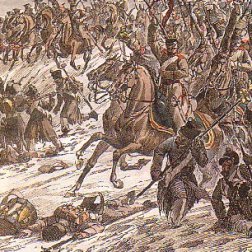 It was on 18th November 1812 at Krasne, that the French 18th Line Regiment,
nicknamed “The Brave” (battle honors: Rivoli 1796, Austerlitz 1805 and Borodino
1812) lost its eagle. Marshal Ney led his troops in a frontal attack that ended in
failure. According to Col. Pierre Pelleport, the 18th Regiment was
“virtually destroyed” by the Lifeguard Uhlans. By Pelleport's order, the
eagle was placed at the head of the regiment although other troops sought to hide
their own eagles by dismantling them or hurrying them to the rear.
Approx. 600 of the Frenchmen became casualties, including 350 dead and few
survived by the skin of their teeth. The infantry fled pell-mell across the
white field, carrying with them the few officers who were trying vainly to rally
them. Officers Koracharov and Bolchwing and uhlan Darchenko of the II Squadron
captured the eagle and flag (drapeau) of the 18th Line and were awarded with the
St. George order.
The entire Lifeguard Uhlan Regiment was awarded with St. George standards with the
inscription "For capturing enemy standard at Krasne and for distinction
in repulsing the enemy from Russia in 1812."
The 18th Line Regiment had requested a replacement eagle for the one lost at Krasne
and Napoleon approved the request in 1813.
It was on 18th November 1812 at Krasne, that the French 18th Line Regiment,
nicknamed “The Brave” (battle honors: Rivoli 1796, Austerlitz 1805 and Borodino
1812) lost its eagle. Marshal Ney led his troops in a frontal attack that ended in
failure. According to Col. Pierre Pelleport, the 18th Regiment was
“virtually destroyed” by the Lifeguard Uhlans. By Pelleport's order, the
eagle was placed at the head of the regiment although other troops sought to hide
their own eagles by dismantling them or hurrying them to the rear.
Approx. 600 of the Frenchmen became casualties, including 350 dead and few
survived by the skin of their teeth. The infantry fled pell-mell across the
white field, carrying with them the few officers who were trying vainly to rally
them. Officers Koracharov and Bolchwing and uhlan Darchenko of the II Squadron
captured the eagle and flag (drapeau) of the 18th Line and were awarded with the
St. George order.
The entire Lifeguard Uhlan Regiment was awarded with St. George standards with the
inscription "For capturing enemy standard at Krasne and for distinction
in repulsing the enemy from Russia in 1812."
The 18th Line Regiment had requested a replacement eagle for the one lost at Krasne
and Napoleon approved the request in 1813.
In Kulm in 1813, the Lifeguard Uhlans fought valiantly: 14 of their officers were killed and
wounded, their commander was knocked off his horse.
In Leipzig in 1813 they pushed back French cuirassiers who earlier broke Lifeguard Hussars and
Lifeguard Dragoons. In 1814 in Sommepy the uhlans broke French cavalry, captured several hundreds of prisoners and
a battery. The ulans also fought at Fère Champenoise and Paris. They distinguished
themselves at Fère Champenoise. The Lifeguard Uhlan Regiment was awarded with 22 St. George
trumpets for campaign of 1814.
It was arguably the best Russian lance-armed unit.
|
|
Lifeguard Hussar Regiment
Russian name: Leib-gvardii Gusarskii Polk
Chef: General of Cavalry Petr H. Wittgenstein
Commander: 1808 - Oct 1813 General-Major (in Aug 1813 GL) Ivan E. Shevich
In 1775 was formed a single squadron of guard hussars by taking the best troopers from the
existing tvelve hussar regiments. This squadron accompanied the empress during solemn
occassions and served as her escort. Tsar Paul ordered to increase its strength
from one to four squadrons and in 1796 entire regiment was formed.
Their uniform was copied from that of the Prussian hussars of Frederick the Great and
their squadrons were given silver trumpets. The Lifeguard Hussars were the ultimate in flamboyance,
for parade their officers wore leopard pelts. Dancing, drinking and romancing were the
highlights of their life in the capital. The sight of the guard hussar in his parade dress
could reverse the flow of the blood in woman's veins. Company commander, Denis Davidov,
with 2 crosses for bravery around his neck and 2 other decorations on his chest,
mentions how his head "was kept in a spin" after being on leave and enjoying Moscow's pleasures.
(Davydov - "In the Service of the Tsar against Napoleon: the memoirs of Denis Davidov,
1806-1814" 1999, p 69)
Austerlitz was their very first appearance on the battlefield and the French Guard
Cavalry routed them. In 1806-1807 the Lifeguard Hussars fought in Heilsberg and Friedland.
For the entire campaign they were awarded with 112 crosses.
(Benkendorf - "Kratkaya Istoriya Leib-Gvardii Gusarskogo Ego Velichestva Polka" 1879)
Before the Battle of Ostrovno in 1812, two squadrons of Lifeguard Hussars acted
as the rear guard of the retreating Russian corps. They routed French 8th Hussars
but during the pursuit the 16th Chasseurs strucked them in the flank. The Russians
were routed and as a result a Russian horse battery and 150 prisoners were
captured. Meshetich, who participated in this fight, gave other version of these
events in “Istoricheskie zapiski.” He wrote that the 2 squadrons noticed French
advance posts in a wood and rushed forward but were met by fire from dismounted
chasseurs deployed on both sides of the road. Behind the wood stood mass of French
cavalry, which soon advanced and threw the Lifeguard Hussars back. The horse battery led
by Kardyba was away from the hussars but lost half of its 12 guns.
In Borodino the Lifeguard Hussars attacked the square of 84th Line Infantry but without horse
artillery and success. They fought very well in Vinkowo against French cuirassiers, and at
Tarutino and Krasne where they captured enemy's battery. In 1813 they fought with
distinction in Lutzen, Bautzen and Leipzig. In Leipzig they were crushed by
French cuirassiers despite a ferocious resistance and sacrifice of their officers.
In April they were awarded with St. George standards for the entire campaign. In 1814 they fought at Fère Champenoise.
|
|
Lifeguard Uhlan Regiment
Russian name: Leib-gvardii Konno-Yegierskii Polk
Chef: General-Lieutenant Prince Vasilchikov
Commander: General-Major Potapov
This regiment was raised in Spring 1814 in ... Paris.
It immediately became one of the favorite units of the monarch.
|
Uniforms of Guard cavalry in 1805-09.
Pictures by Viskovatov, Russia.
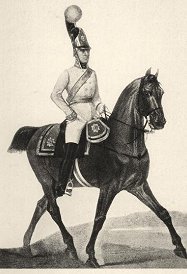

Left: officer of Guard Cavalry Regiment 1804-07,
Right: officer of Lifeguard Hussars 1802-09,
Uniforms of Guard cavalry in 1812-15.
Pictures by Andre Jouineau, France.
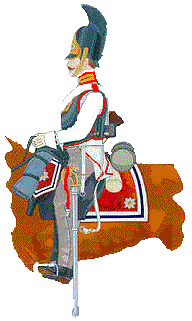
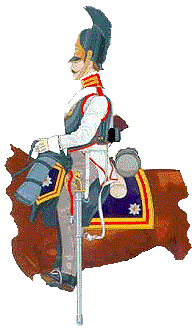
Left: private of Guard Cavalry Regiment (Chevaliers Garde) 1812
Right: private of Lifeguard Horse (Garde du Corps) 1812

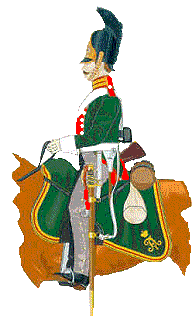

Left: private of Lifeguard Uhlans 1812
Center: private of Lifeguard Dragoons 1812
Right: Lifeguard Hussars 1812
|
|

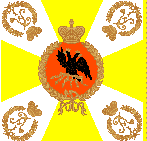


 Guard's prestige came from their position of being the monarch's guard.
Decades before the Napoleonic Wars the Russian Guard served political functions, prepared nobles to officer rank and provided officers to the army.
The Guard was less and less participating in combat and no guard regiments as such
participated in the bloody Seven Years War against the Prussians.
They became very comfortable in St. Petersburg where they were stationed.
Guard's prestige came from their position of being the monarch's guard.
Decades before the Napoleonic Wars the Russian Guard served political functions, prepared nobles to officer rank and provided officers to the army.
The Guard was less and less participating in combat and no guard regiments as such
participated in the bloody Seven Years War against the Prussians.
They became very comfortable in St. Petersburg where they were stationed.
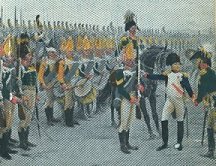 Picture: --> in 1807, during signing the Peace Treaty in Tilsit, Napoleon was invited
to review the Russian Guard. The treaty ended war between Russia and France and began an alliance between
the two empires which rendered the rest of Europe almost powerless.
Picture: --> in 1807, during signing the Peace Treaty in Tilsit, Napoleon was invited
to review the Russian Guard. The treaty ended war between Russia and France and began an alliance between
the two empires which rendered the rest of Europe almost powerless.
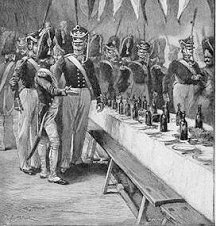 The Guards ate standing.
The Guards ate standing.
 Commander of Imperial Guard Grand Duke Constantine (1779-1831).
Commander of Imperial Guard Grand Duke Constantine (1779-1831).



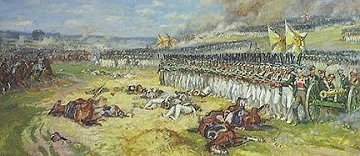 Picture: Lithuanian Lifeguard Regiment
versus French cuirassiers in the battle of Borodino in 1812.
Picture by Chagadayev, Russia.
Picture: Lithuanian Lifeguard Regiment
versus French cuirassiers in the battle of Borodino in 1812.
Picture by Chagadayev, Russia.

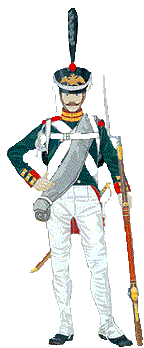
 Preobrazhensk Lifeguard Regiment (left),
Preobrazhensk Lifeguard Regiment (left), 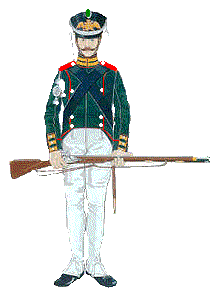 The Preobrazhensk Regiment was the senior regiment of Russian infantry.
Tzar Peter the Great formed this unit in 1695 and they were the first unit organized
in modern European style.
During the Napoleonic Wars Tzar Alexander often wore their uniform.
For example in 1807 during the signing of Peace Treaty.
(Davidov -"In the Service of the Tzar against Napoleon:the memoirs of Denis Davidov ..." 1999, p 58)
The Preobrazhensk Regiment was the senior regiment of Russian infantry.
Tzar Peter the Great formed this unit in 1695 and they were the first unit organized
in modern European style.
During the Napoleonic Wars Tzar Alexander often wore their uniform.
For example in 1807 during the signing of Peace Treaty.
(Davidov -"In the Service of the Tzar against Napoleon:the memoirs of Denis Davidov ..." 1999, p 58) Picture: officer of Lifeguard Horse (Garde du Corps, Horse Guard) present captured French Color
to the monarch. Battle of Austerlitz, 1805. Picture by Viktor Mazurovsky, Russia.
Picture: officer of Lifeguard Horse (Garde du Corps, Horse Guard) present captured French Color
to the monarch. Battle of Austerlitz, 1805. Picture by Viktor Mazurovsky, Russia.
 It was on 18th November 1812 at Krasne, that the French 18th Line Regiment,
It was on 18th November 1812 at Krasne, that the French 18th Line Regiment,








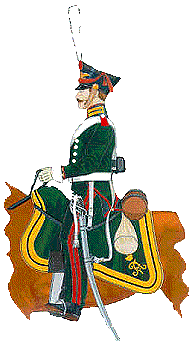 Left: Guard foot gunner. Picture by Andre Jouineau.
Left: Guard foot gunner. Picture by Andre Jouineau.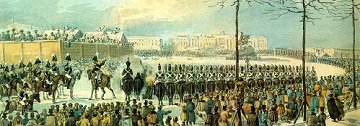 In 1825 there were more than two thousand soldiers in Senate Square in St. Petersburg taking
part in an uprising. Due to lack of unity of command and little support from the civilians
the uprising failed.
In 1825 there were more than two thousand soldiers in Senate Square in St. Petersburg taking
part in an uprising. Due to lack of unity of command and little support from the civilians
the uprising failed.
